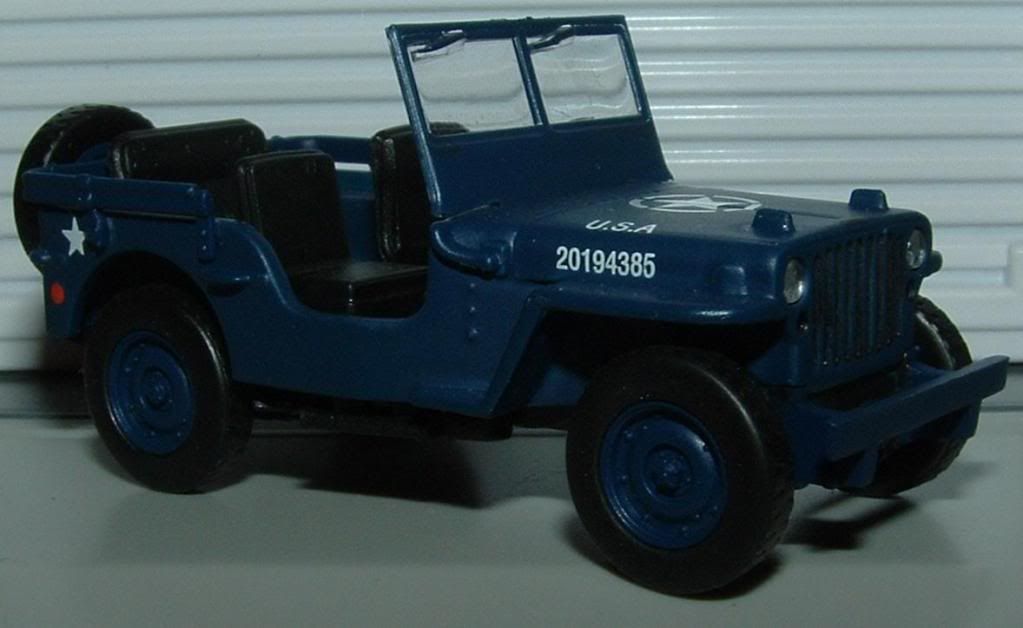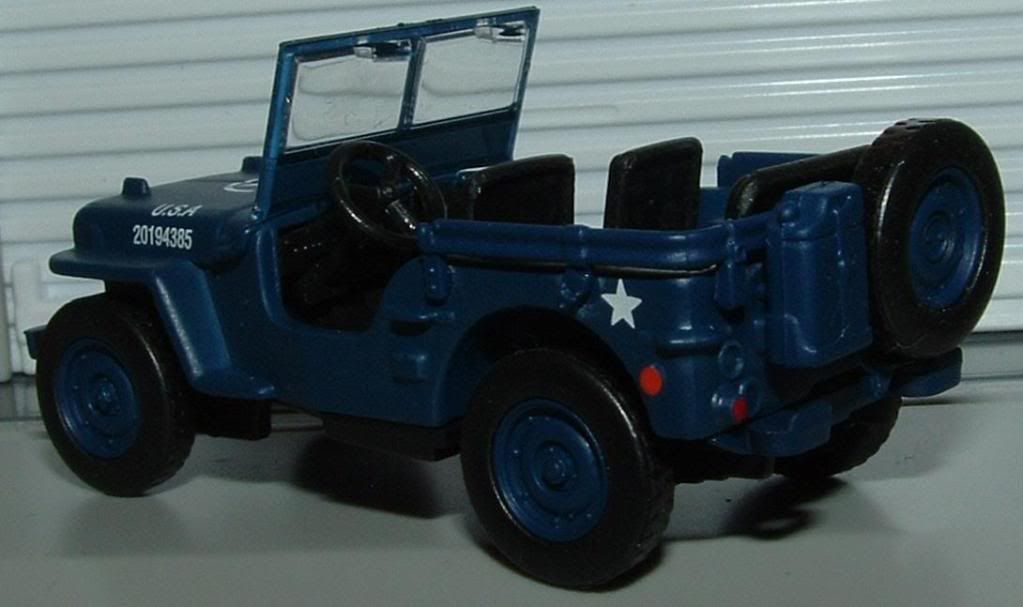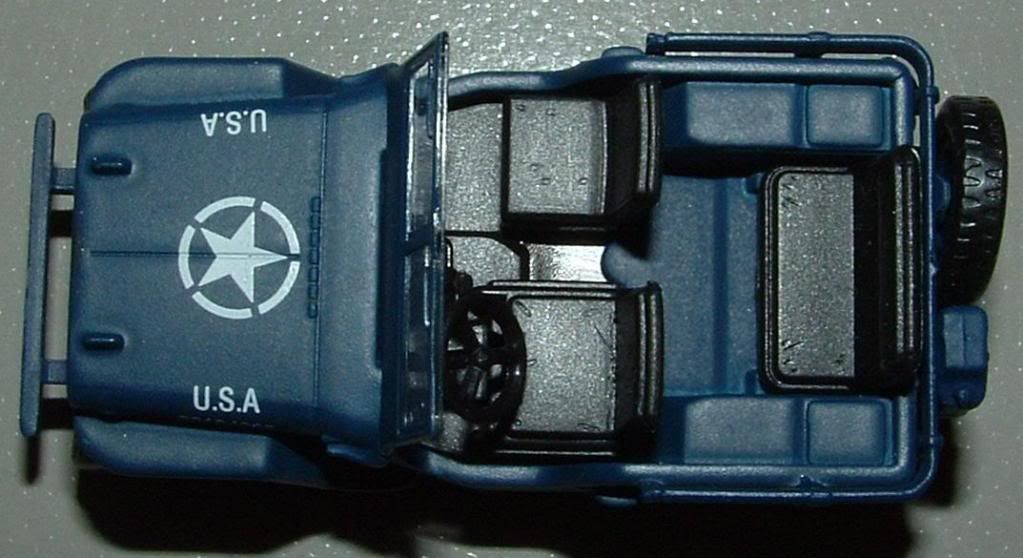Today's car of the day is Kyosho's 1943 Willys MB.
The Willys MB US Army Jeep (formally the Truck, 1/4 ton, 4x4) and the Ford GPW, was manufactured from 1941 to 1945. The small four-wheel drive utility vehicles are considered the iconic World War II Jeep, and inspired many similar light utility vehicles. Over the years, the World War II Jeep later evolved into the "CJ" civilian Jeep. Its counterpart in the German army was the Volkswagen Kübelwagen, also based on a small automobile, but which used an air-cooled engine and lacked 4 wheel drive.
For more information and pictures of the real car please visit: Willys MB
Another recent Kyosho release, this is Jeep sports US Navy colors and looks quite sharp.
By now the war was underway in Europe, so the Army's need was urgent and demanding. Bids were to be received by July 22, a span of just eleven days. Manufacturers were given 49 days to submit their first prototype and 75 days for completion of 70 test vehicles. The Army's Ordnance Technical Committee specifications were equally demanding: the vehicle would be four-wheel drive, have a crew of three on a wheelbase of no more than 75 (later 80) inches and tracks no more than 47 inches, feature a fold-down windshield, 660 lb payload and be powered by an engine capable of 85 ft·lbf (115 N·m) of torque. The most daunting demand, however, was an empty weight of no more than 1,300 lb (590 kg).
Only two companies entered: American Bantam Car Company and Willys-Overland Motors. Though Willys-Overland was the low bidder, Bantam received the bid, being the only company committing to deliver a pilot model in 49 days and production examples in 75. Under the leadership of designer Karl Probst, Bantam built their first prototype, dubbed the "Blitz Buggy" (and in retrospect "Old Number One"), and delivered it to the Army vehicle test center at Camp Holabird, Maryland on September 23, 1940. This presented Army officials with the first of what eventually evolved into the World War II U.S. Army Jeeps: the Willys MB and Ford GPW.
Since Bantam did not have the production capacity or fiscal stability to deliver on the scale needed by the War Department, the other two bidders, Ford and Willys, were encouraged to complete their own pilot models for testing. The contract for the new reconnaissance car was to be determined by trials. As testing of the Bantam prototype took place from September 27 to October 16, Ford and Willys technical representatives present at Holabird were given ample opportunity to study the vehicle's performance. Moreover, in order to expedite production, the War Department forwarded the Bantam blueprints to Ford and Willys, claiming the government owned the design. Bantam did not dispute this move due to its precarious financial situation. By November 1940, Ford and Willys each submitted prototypes to compete with the Bantam in the Army's trials. The pilot models, the Willys Quad and the Ford Pygmy, turned out very similar to each other and were joined in testing by Bantam's entry, now evolved into a Mark II called the BRC 60. By then the U.S. and its armed forces were already under such pressure that all three cars were declared acceptable and orders for 1,500 units per company were given for field testing. At this time it was acknowledged the original weight limit (which Bantam had ignored) was unrealistic, and it was raised to 2,160 pounds (980 kg).
For these respective pre-production runs, each vehicle received revisions and a new name. Bantam's became the BRC 40, and the company ceased motor vehicle production after the last one was built in December 1941. After reducing the vehicle's weight by 240 pounds, Willys' changed the designation to "MA" for "Military" model "A". The Fords went into production as "GP", with "G" for a "Government" type contract and "P" commonly used by Ford to designate any passenger car with a wheelbase of 80 inches.
By July 1941, the War Department desired to standardize and decided to select a single manufacturer to supply them with the next order for another 16,000 vehicles. Willys won the contract mostly due to its more powerful engine (the "Go Devil") which soldiers raved about, and its lower cost and silhouette. The design features the Bantam and Ford entries had which were an improvement over Willys' were then incorporated into the Willys car, moving it from an "A" designation to "B", thus the "MB" nomenclature. Most notable was a flat wide bonnet, adapted from Ford GP.
By October 1941, it became apparent Willys-Overland could not keep up with production demand and Ford was contracted to produce them as well. The Ford car was then designated GPW, with the "W" referring to the "Willys" licensed design. During World War II, Willys produced 363,000 Jeeps and Ford some 280,000. Approximately 51,000 were exported to the U.S.S.R. under the Lend-Lease program.
A further 13,000 (roughly) amphibian jeeps were built by Ford under the name GPA (nicknamed 'Seep' for Sea Jeep). Inspired by the larger DUKW, the vehicle was produced too quickly and proved to be too heavy, too unwieldy, and of insufficient freeboard. In spite of participating successfully in the Sicily landings (July 1943) most GPAs were routed to the U.S.S.R. under the Lend-Lease program. The Soviets were sufficiently pleased with its ability to cross rivers to develop their own version of it after the war (GAZ-46).







No comments:
Post a Comment